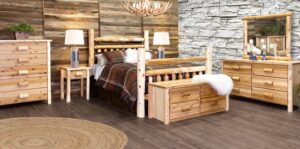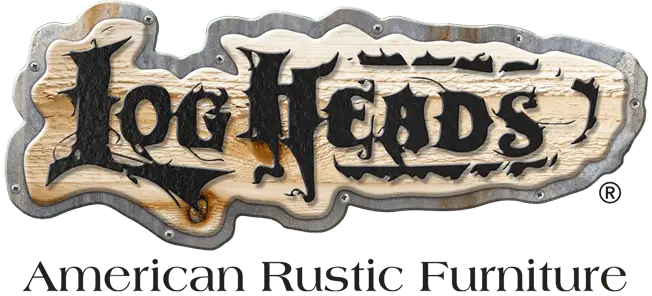Log Furniture doesn’t get more local than this!
Log Furniture in Kentucky or Tennessee does not get more local than this. Tommy and his crew handcraft every single piece of furniture at LogHeads Home Center. There’s nothing automated in their manufacturing process. And when Tommy, Gwen, and the LogHeads family tell folks that their furniture is custom-made for them, it truly is, because no two pieces of wood are exactly the same.
How do Tommy and his team create these pieces? Let’s go behind the scenes to find out how this heirloom-quality furniture is made. Here’s what happens before it arrives in your home.
Start with Premium Lumber
The big trucks bring in the lumber, Cedar, or Hickory logs. Tommy orders the logs in the diameters he’ll need for furniture legs, headboards, etc. – all the options he’ll need for each design. Tommy and his crew unload and put the lumber in drying sheds. Each piece of wood needs to be as dry as possible for production. So the wood needs to be rotated, the drier lumber is stacked up front and the new logs are put in the back to give them more drying time.
“So that’s the first process, just rotating the wood and getting it ready for production,” explains Tommy, “and then you pull as you need.”
Hand-Drawn Designs, John Wayne Inspired
All of the furniture designs are drawn by hand. Many of the designs are inspired by Tommy’s love of Westerns.
“A lot of my ideas come from watching Western movies. I like all of the John Wayne movies” says Tommy. “If you look at some of those old movies, you see the log furniture. I think it’s cool. It sparks something in me. Then I’ll try to build it, make it better.”
Hand-Selected Wood, Hand-Sanded Too
Even though the designs are established for consistency, Tommy and his crew handpick the logs and boards for each part of each piece. A great deal of thought goes into each decision. For furniture legs, for example, the team is trained to pull logs that are all close in diameter. For tops of tables and dressers, they start with rough-cut boards and mill it themselves. Then they select what they call a “clean board” and match it together.
“If it’s for the top of a dining room table, you’ve gotta eyeball each board. You need a nice surface, not too many knots, and see what’ll look good together,” Tommy explains. “And we hand match each one of those boards, every bit of it.”
It’s a time-consuming process, but it’s what’s needed in order to create the quality LogHeads is famous for. This is not a team that cuts corners in any aspect of production. For example, the ElkRidge line is all sanded by hand in order to keep its signature a full-character look.
“There’s no machine you could run it through and keep the rustic integrity that you want,” Tommy offers. “You’ve got to hand-sand each ElkRidge piece. So it’s very labor-intensive.”
Once they’ve selected the wood, it’s time to cut it and glue it together. Even the “gluing-up” process embraces tradition at LogHeads.
Gluing Up – It Takes Time to Get it Right
Tommy and the team glue their furniture the old-fashioned way, with clamp racks. They put the boards in, hand glue the edges, put them in clamps, and leave them in overnight.
“A lot of your big manufacturers do this step electronically so it’s all automated. It’s quicker that way, but we like to take our time with this step for quality control,” Tommy explains. “That’s why we do it the old-fashioned way with clamps.”
LogHeads only uses water-based glues because it contains fewer potentially hazardous chemicals (like formaldehyde) than oil-based glues that big manufacturers typically use.
Premium Finish – You Get What You Pay For
When selecting finishes for rustic furniture, there are two major considerations. The first is called “ambering”. You’ll notice that some rustic furniture takes on a yellow sheen as it ages. That’s the clear finish turning yellow, or ambering. Tommy aims to reduce ambering, so the finish stays as clear as possible and the furniture keeps its original color.
The second consideration is the chemical composition of the finish itself. Tommy aims to have the lowest amount of formaldehyde possible in all of his pieces. So he pays top dollar to ensure his finishes reduce both ambering risk and formaldehyde levels.
“I pay almost double for a finish that has the lowest amount of formaldehyde available, and also, it won’t amber as much. So our furniture will keep its natural wood color over time. So we do pay extra for that,” Tommy says. “I strongly believe you get what you pay for, so I always go that route.”
No Shortcuts and it Shows
Each piece is crafted with care. Authentic, thoughtful manufacturing is at the heart of what makes LogHeads special. And that way of thinking spills over into their creativity, customer service, and way of doing business. There’s simply no substitute for genuine love and devotion.
God Bless,
Gwen & Tommy








